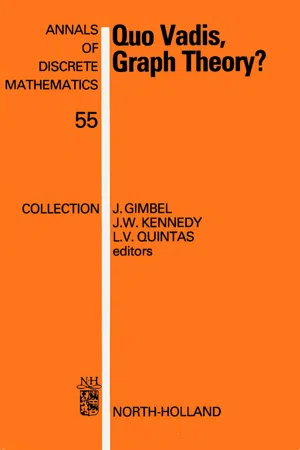
eBook - PDF
Quo Vadis, Graph Theory?
A Source Book for Challenges and Directions
- 396 pages
- English
- PDF
- Available on iOS & Android
eBook - PDF
Quo Vadis, Graph Theory?
A Source Book for Challenges and Directions
About this book
Graph Theory (as a recognized discipline) is a relative newcomer to Mathematics. The first formal paper is found in the work of Leonhard Euler in 1736. In recent years the subject has grown so rapidly that in today's literature, graph theory papers abound with new mathematical developments and significant applications.As with any academic field, it is good to step back occasionally and ask Where is all this activity taking us?, What are the outstanding fundamental problems?, What are the next important steps to take?. In short, Quo Vadis, Graph Theory?. The contributors to this volume have together provided a comprehensive reference source for future directions and open questions in the field.
Frequently asked questions
Yes, you can cancel anytime from the Subscription tab in your account settings on the Perlego website. Your subscription will stay active until the end of your current billing period. Learn how to cancel your subscription.
At the moment all of our mobile-responsive ePub books are available to download via the app. Most of our PDFs are also available to download and we're working on making the final remaining ones downloadable now. Learn more here.
Perlego offers two plans: Essential and Complete
- Essential is ideal for learners and professionals who enjoy exploring a wide range of subjects. Access the Essential Library with 800,000+ trusted titles and best-sellers across business, personal growth, and the humanities. Includes unlimited reading time and Standard Read Aloud voice.
- Complete: Perfect for advanced learners and researchers needing full, unrestricted access. Unlock 1.4M+ books across hundreds of subjects, including academic and specialized titles. The Complete Plan also includes advanced features like Premium Read Aloud and Research Assistant.
We are an online textbook subscription service, where you can get access to an entire online library for less than the price of a single book per month. With over 1 million books across 1000+ topics, we’ve got you covered! Learn more here.
Look out for the read-aloud symbol on your next book to see if you can listen to it. The read-aloud tool reads text aloud for you, highlighting the text as it is being read. You can pause it, speed it up and slow it down. Learn more here.
Yes! You can use the Perlego app on both iOS or Android devices to read anytime, anywhere — even offline. Perfect for commutes or when you’re on the go.
Please note we cannot support devices running on iOS 13 and Android 7 or earlier. Learn more about using the app.
Please note we cannot support devices running on iOS 13 and Android 7 or earlier. Learn more about using the app.
Yes, you can access Quo Vadis, Graph Theory? by J. Gimbel,J.W. Kennedy,L.V. Quintas in PDF and/or ePUB format, as well as other popular books in Mathematics & Discrete Mathematics. We have over one million books available in our catalogue for you to explore.
Information
Table of contents
- Front Cover
- Quo Vadis, Graph Theory?
- Copyright Page
- CONTENTS
- Foreword
- Chapter 1. Whither graph theory?
- Chapter 2. The future of graph theory
- Chapter 3. New directions in graph theory (with an emphasis on the role of applications)
- Chapter 4. A survey of (m,k)-colorings
- Chapter 5. Numerical decks of trees
- Chapter 6. The complexity of colouring by infinite vertex transitive graphs
- Chapter 7. Rainbow subgraphs in edge-colorings of complete graphs
- Chapter 8. Graphs with special distance properties
- Chapter 9. Probability models for random multigraphs with applications in cluster analysis
- Chapter 10. Solved and unsolved problems in chemical graph theory
- Chapter 11. Detour distance in graphs
- Chapter 12. Integer-distance graphs
- Chapter 13. Toughness and the cycle structure of graphs
- Chapter 14. The Birkhoff-Lewis equations for graph-colorings
- Chapter 15. The complexity of knots
- Chapter 16. The impact of F-polynomials in graph theory
- Chapter 17. A note on well-covered graphs
- Chapter 18. Cycle covers and cycle decompositions of graphs
- Chapter 19. Matching extensions and products of graphs
- Chapter 20. Prospects for graph theory algorithms
- Chapter 21. The state of the three color problem
- Chapter 22. Ranking planar embeddings using PQ-trees
- Chapter 23. Some problems and results in cochromatic theory
- Chapter 24. From random graphs to graph theory
- Chapter 25. Matching and vertex packmg: How “hard”are they?
- Chapter 26. The competition number and its variants
- Chapter 27. Which double starlike trees span ladders?
- Chapter 28. The random ƒ-graph process
- Chapter 29. Quo vadis, random graph theory?
- Chapter 30. Exploratory statistical analysis of networks
- Chapter 31. The Hamiltonian decomposition of certain circulant graphs
- Chapter 32. Discovery-method teaching in graph theory
- Chapter 33. Index of Key Terms